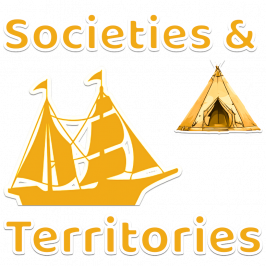About 5 000 years ago, groups of people from Alaska and Siberia, in Asia, migrated to the Arctic region. They traveled across the Bering Strait, by walking across the frozen water in the winter or by using boats in the summer. By the year 1000, the ancestorsAncestors - An ancestor is a person who is related to someone but lived many years/... of the Inuit had arrived in Northern Canada. Groups settled along the shores of Ungava Bay, Hudson’s Bay, and later on, in Labrador. Around the year 1500, about 3 000 Inuit people lived in Northern Quebec and in Labrador.
The first people living on this territoryA territory is an area of land, or sometimes of sea, that we can say "belongs"... adapted their lifestyle to the difficult environmental conditions of the Great North. Depending on the seasons, they survived by hunting land and aquatic mammals (such as muskox, caribou, whales, seals, and walruses), as well as fishing and gathering.
The Inuit developed many ingenious tools and strategies to deal with the difficulties associated with living on their territoryA territory is an area of land, or sometimes of sea, that we can say "belongs".... They developed various means of transportation, like kayaks, other boats called oumiak, and qamutik (dog sleds). They invented dwellings, (like igloos), clothingClothing- Items made from fabric, skins, or other materials that serve to protect and cover the... (like snow goggles), and other items that were essential for survival, (such as a Qulliq, a kind of oil lamp made of soapstone). Because of their history, their lifestyle, and their traditions, the Inuit are quite different from other Indigenous peoples living in southern Quebec.
The Inuit lifestyle changed when they came into contact with EuropeansContact with Europeans- When European settlers arrived in North America and came into initial contact with....
Qallunaat: Europeans
At the end of the 15th century, the Inuit had encountered European explorers, fishermen, and hunters. They called these foreigners Qallunaat. At that time, the meetings between the Inuit and Europeans were brief. They lasted only long enough to barterBarter means to trade services or things for other services or things, but without using money!.
When trading posts were established in the 18th century, contact between the Inuit and European merchants and missionaries, who wanted to convert the Inuit to CatholicismCatholicism - Catholicism refers to the catholic religion. Catholics believe in the bible and that Jesus..., became more and more frequent. The traditional lifestyle of the Inuit began to change.
Inuit were traditionally nomadicA nomad is someone who lives by travelling from place to place. Nomadic thus means anything that involves... people who lived off of the land. ColonizationColonizationColonization occurs when one country takes control of another country, territory, or people. It happens when... changed this. Around 1950, European policies forced Inuit in Quebec, and other areas of Canada, to lead more sedentarySedentary means to live in one place, to grow one's own food, and to build more... lifestyles and permanent villages were built in Nunavik.
In 1980, there were about 5 000 Inuit living in northern Quebec.
AuthorAuthor - A person who writes something Auteur - Une personne qui écrit quelque chose: Based on texts from the Récit de l’univers social. Adapted with additions by LEARN.
Additional Images and More Recent Times!
See also – Traces of the past:
Links:











